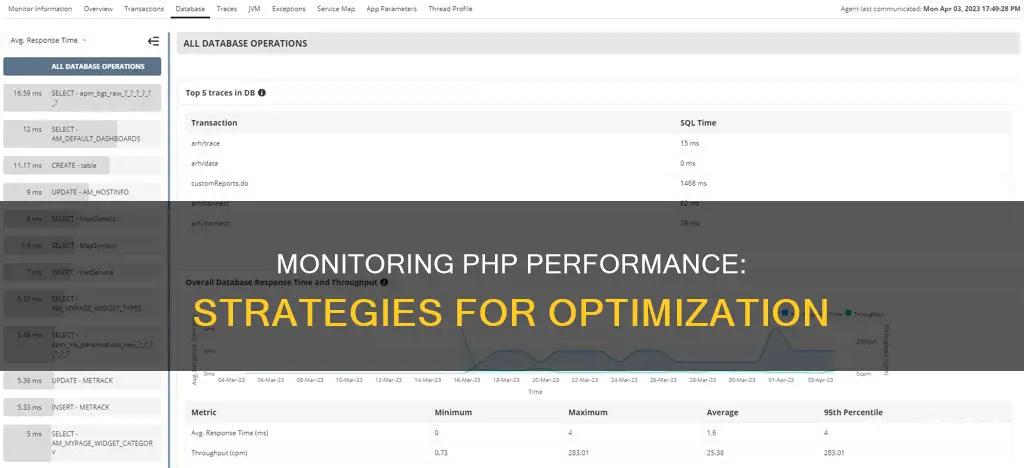
PHP application performance monitoring is essential to ensure a seamless user experience and to identify and fix errors. There are various tools available to monitor PHP performance, such as APM Insight's PHP APM monitoring agent, which provides valuable data on parameters like response times, throughput, and exceptions. This data can be used to optimise PHP server performance and improve user satisfaction. Monitoring PHP performance is crucial to maintaining consistent performance and uninterrupted service for website visitors.
| Characteristics | Values |
|---|---|
| Application Performance Monitoring (APM) Tools | NewRelic, Tideways, Pinba, Blackfire.io, Monit, Sentry, PMM, Cloudways Platform, Retrace, Atatus |
| APM Features | Response time, Apdex score, exception rate, query time, SLA report, HTTP failure rates, transaction monitoring, database monitoring, slow request traces, external request monitoring, API failures, release tracking, error tracking |
| Other Tools | CloudWatch, ManageEngine Applications Manager, PHP Server Monitor, Stackify |
What You'll Learn

Monitoring PHP exceptions
Tools for Monitoring
There are several tools available to help you monitor PHP exceptions. Here are some popular options:
- Sentry: Sentry is a platform that focuses on exception monitoring. It provides actionable insights to resolve PHP performance issues and errors. It offers features such as complete stack traces, filtering and grouping of exceptions, and the ability to expose important events leading to exceptions.
- Bugsnag: Bugsnag is another error monitoring and exception reporting tool for PHP applications. It provides instant notifications of errors and exceptions, supports various PHP frameworks, and allows you to attach user information to understand the impact of crashes.
- Stackify: Stackify offers a comprehensive suite of tools, including Retrace, which helps in monitoring and troubleshooting PHP applications. It provides features like code profiling, transaction tracing, error tracking, and application monitoring.
- PHP Server Monitor: This open-source tool monitors your servers and websites, providing notifications and uptime and latency history through a web-based interface.
- ManageEngine Applications Manager: This tool offers PHP performance monitoring, helping you track parameters like response times, throughput, and exceptions. It provides transaction details, database operation insights, and automated service mapping for application dependency analysis.
Advanced Techniques for Exception Handling
- Try-Catch Blocks: PHP version 5 and later have a built-in model for handling exceptions using try-catch blocks. When an exception is thrown, PHP searches for a corresponding catch statement to handle it. You can also use multiple catch blocks to customize error handling based on exception types.
- Custom Exception Types: PHP allows you to create custom exception classes by extending the built-in Exception class. This gives you more control over how exceptions are handled and displayed to users.
- Global Exception Handling: It is a best practice to configure a global exception handler using the set_exception_handler() function. This ensures that any unhandled exceptions are caught and processed appropriately.
- Logging and Troubleshooting: Proper logging of exceptions is crucial for effective troubleshooting. Tools like Monolog, a standard PHP logging library, or error-tracking solutions like Stackify's Retrace, can help you centralize and analyze exceptions in one place.
By utilizing these tools and techniques, you can effectively monitor and manage PHP exceptions, ensuring the stability and reliability of your PHP applications.
Blind Spot Monitor: Lexus GS 350's Superpower?
You may want to see also

Identifying slow queries
Understanding the Problem
Firstly, it's important to understand that slow SQL queries can significantly impact the performance of your PHP applications or websites. These queries may be the result of poorly written code or they may have been fast at one point but slowed down as the database grew larger. Identifying and optimising these slow queries can greatly improve the overall performance.
Tools for Identification
There are several tools available to help identify slow queries:
- Query Monitor Plugin: This plugin provides detailed information about the current page, including the number of queries, which queries took the longest, and which functions spent the most time on SQL queries. It also identifies slow queries with red text for easy recognition.
- Debug Bar Plugin: This plugin provides information about the internal workings of a page, including request information and the SQL queries generated. While it doesn't highlight slow queries, it provides a function trace that points to the source of the query.
- New Relic: This is a service that measures and monitors the performance of your web app, including PHP applications. It provides detailed insights into the performance of your PHP code, down to the number of milliseconds spent in each function. It also tracks every request to your site, making it easier to find slow queries.
- PHP-FPM Slow Log: This is a built-in feature of PHP-FPM that records a stack trace and saves it for later inspection when a page takes longer than a configured threshold (e.g., 10 seconds) to render. Stack traces show all active functions and their locations in the source code, helping to identify bottlenecks.
Optimisation Strategies
Once you've identified the slow queries, there are several strategies you can employ to optimise them:
- Change the Query: Rewriting the query can sometimes yield significant improvements. For example, using the DISTINCT statement instead of GROUP BY to select unique values.
- Add an Index: MySQL indexes organise data in a table to make it easier to locate, reducing the amount of scanning required for each query. However, be cautious as indexes can slow down other queries like INSERT and UPDATE, and they make writing to the table slower.
- Cache the Query Results: Instead of changing the query, you can store the results using a caching mechanism like the WordPress Transients API. This reduces the frequency of running the slow query.
Switching to HDMI Mode: ASUS Monitor Default Settings
You may want to see also

Monitoring application dependencies
One way to monitor application dependencies is through tools like Retrace, which provide code-level Application Performance Monitoring (APM). Retrace can identify common dependencies and track their performance, helping you pinpoint issues related to specific dependencies. It also offers advanced customization features for monitoring web services. Additionally, Retrace allows you to monitor specific SQL queries, which is crucial for maintaining the quality of service of your application.
Another tool for monitoring application dependencies is PHP DA (Dependency Analyzer). This tool helps you check and support dependencies inside your project. It ensures that the dependencies in your project are defined as a graph, allowing you to identify any classes that use dependencies that do not satisfy the defined dependency graph. This can be useful for maintaining low coupling in your application and making structural changes visible to all developers.
Furthermore, ManageEngine's PHP performance monitoring tool provides insights into database operations, such as database transaction response times, the number of invocations, and throughput details. This information can help you identify operations that are taking longer than expected and optimize the performance of your PHP application.
Removing Tile Buttons with Actual Multiple Monitors: A Simple Guide
You may want to see also

Monitoring application logs
- Know the Right Log Level to Use: Understand the different logging levels and when to use each. For example, use the "Emergency" level when the system is unusable, and the "Alert" level when immediate action is required. Other levels include "Critical", "Error", "Warning", "Notice", "Info", and "Debug".
- Know What to Write in a Log Message: Log messages should be human-readable and include timestamps, unique identifiers, and information about the source of the error, such as the class, function, and file.
- Centralize Logging: Store logs in a centrally accessible location to ensure that all relevant information is readily available when needed. This can be done using a dedicated logging server or a commercial logging solution.
- Understand the Difference Between Domain and Framework Messages: Domain messages relate to events within the business logic of your application, while framework messages relate to libraries, frameworks, and other low-level code used by your application.
- Use a Logging Library: Utilize a logging library like Monolog to enhance your logging capabilities. Monolog allows you to create and organize logs using loggers and channels, route logs using handlers, and format logs using formatters.
- Log Events, Not Just Errors: In addition to errors, log custom events such as API calls, logins, logouts, signups, and transactions to monitor your application's performance and usage trends.
- Catch and Log Exceptions: PHP uses exceptions to handle unintended behaviour. Create exception handlers that log useful information about the exception, including the exception object, to help identify and address issues.
Removing Monitor Arms: A Step-by-Step Guide from Your Desk
You may want to see also

Visualising application topology
There are a number of tools available to help with this. ManageEngine's PHP performance monitoring tool has an automated service mapping feature, which allows you to visualise these dependencies and analyse the critical metrics of the external components associated with your application. You can also get a list of the top 5 entries for all critical metrics, as well as information about the health and operational status of all the components. This means you can quickly identify issues and understand which other components may be affected by a failing service.
Another option is AppDynamics, which delivers a capability to visualise the services path including traceability from end to end for each interaction, from the user through all the service calls, along with the infrastructure. This is the most advanced topology visualisation on the market to manage complex architectures.
There are also open-source options, such as Spigo, which is built on d3 JavaScript. While this tool doesn't currently have real-time capabilities, they will be added in the future.
Other tools that can help with PHP application performance monitoring include:
- New Relic
- Sentry.io
- PHP Server Monitor
- Atatus
- Retrace
- Instana
- Dynatrace
- Datadog
- Site24x7 APM Insights
- AppOptics
- Raygun
Troubleshooting ASUS Monitor: Flashing Issue
You may want to see also
Frequently asked questions
PHP performance monitoring helps you identify errors and fix them promptly. It also helps you to improve your application's speed, accuracy and scalability.
Some PHP performance monitoring tools include:
- Retrace
- NewRelic
- Tideways
- Pinba
- Blackfire.io
- Monit
- Sentry
- PMM
- Blackfire
- Alertsite
- Atatus
Some key performance indicators to monitor are:
- Response time
- Apdex score
- Exception rate
- Query time
- SLA report
- HTTP failure rates
Some common mistakes made while developing a PHP application are:
- Creating too many database queries
- Misconfiguring the web server
- Loading too many files
- Sleep method inside a call function
- External API requests
To monitor a server, you can use a script such as PHP Server Monitor, which checks if your websites and servers are up and running. It also provides a web-based user interface for easy management.







